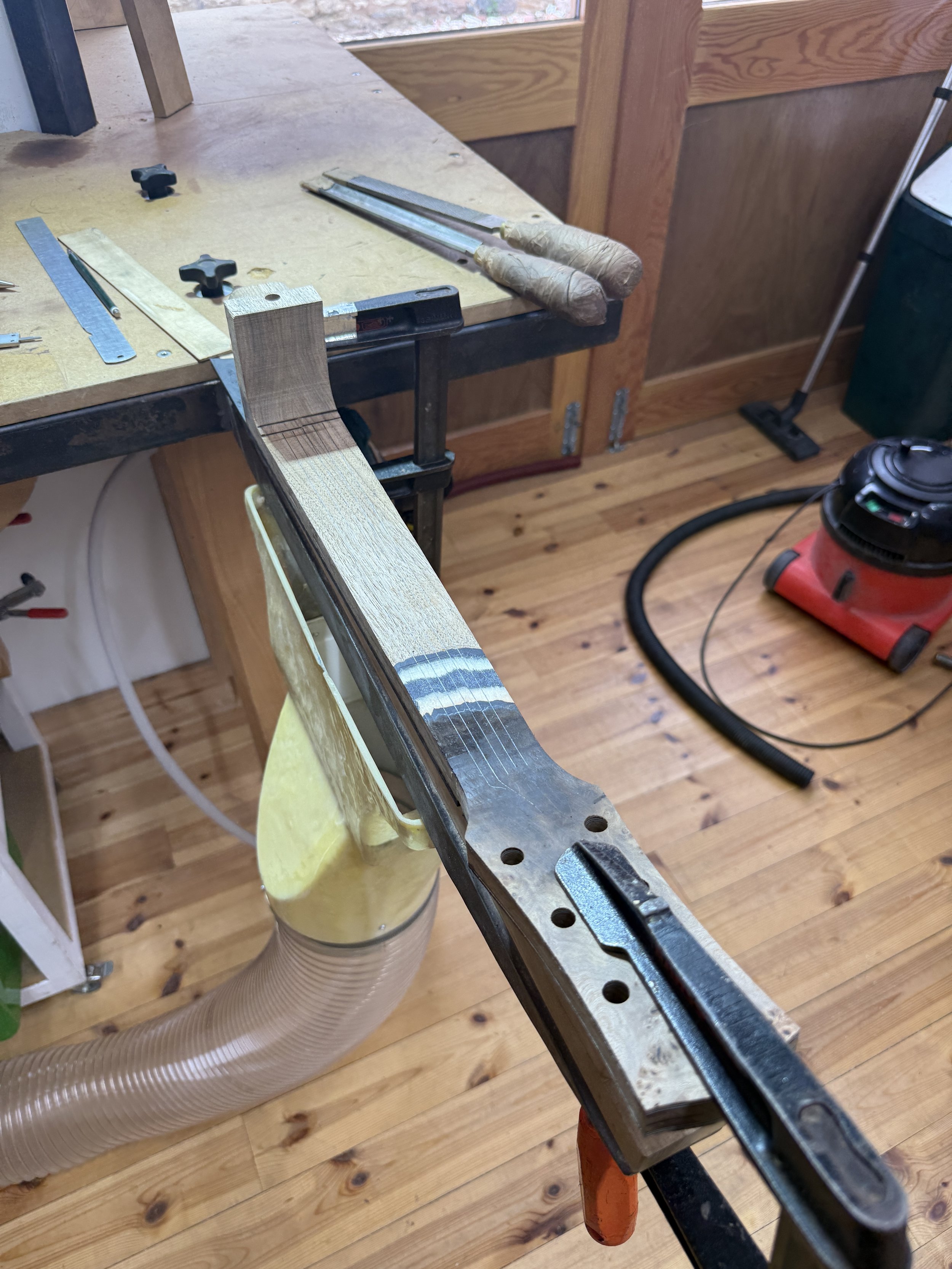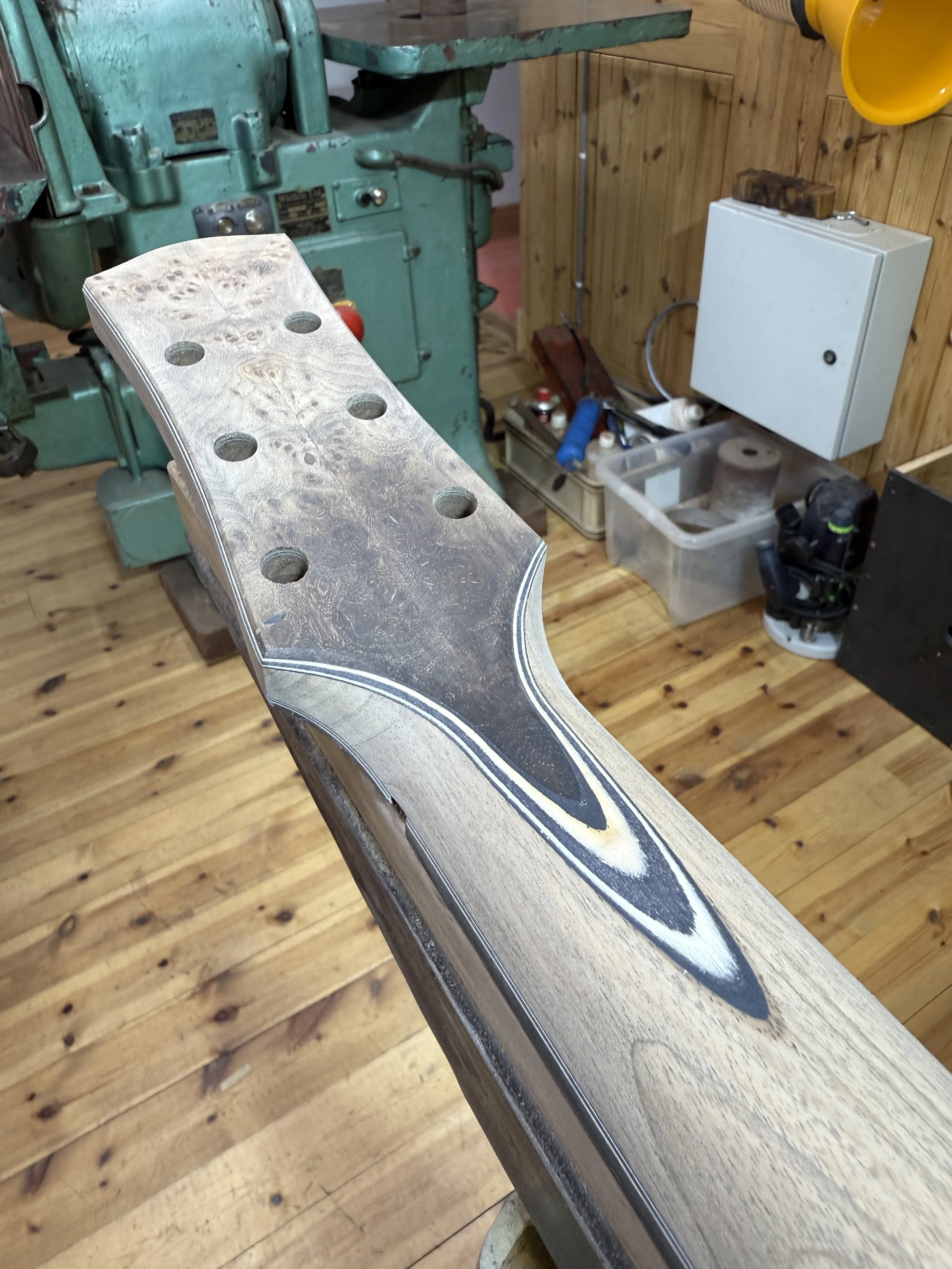Sungha Jung Build Thread
For most of you, Sungha Jung needs no introduction. Hailing from South Korea, Sungha is one of the world’s most renowned fingerstyle guitarists, with a YouTube following of over 7 million people! His intricate playing style and musicality have captivated audiences around the globe.
Over the past few years we’ve been delighted to see and hear Sungha Jung demoing some of our guitars through our fantastic dealers in Seoul, WoodSound. His effortless touch and expressive sound pair beautifully with the tone of a Taran Guitar.
We’re now incredibly excited to share that we’ve been working closely with Sungha and have recently started crafting his very own Tirga Beag! Designed primarily for recording this custom build will highlight our signature Taran sound - crystal clear, well balanced, with rich, articulate trebles.
To achieve this, we’ve chosen:
Back and sides: Stunning Madagascan Rosewood for its depth and clarity.
Soundboard: Master grade Italian Spruce to capture every nuance of Sungha’s playing.
Neck: Scottish Walnut - a recent favourite of ours - adding a touch of warmth to complement the guitar’s clarity.
Starting The Build
The first part of our build process is to get the “prep” work done. This means joining the soundboard and back, thicknessing the plates and sides, bending the sides and getting the rest of the materials for the build roughed out (e.g. neck, fingerboard, headplates, braces etc.).
Once these elements are ready, we give the wood time to settle. Even with well-seasoned materials, the process of thicknessing and bending introduces tension — the wood needs time to adjust to its new form. Our warm and carefully controlled workshop provides the perfect environment for this stage.
Once everything has settled, the build will begin in earnest, and we’re looking forward to sharing the journey with you.
Constructing the Sides
With the wood now rested, our head luthier Zachie has set Sungha’s build in motion.
The way that our sides are constructed has evolved a lot over the past few years. While the core philosophy remains the same, we’ve made many subtle refinements - and together, those small changes make a tangible difference to the final sound of the instrument.
The principle is simple: we want the sides to be as rigid and lightweight as possible. This helps to ensure the energy from the strings stays focused in the soundboard rather than being lost to the sides. We often liken it to a drum, where the flexible drumskin creates the sound, and the solid metal rim and rigid sides helps to concentrate and direct the energy into that skin.
Our fully kerfed laminated sides are incredibly stiff and lightweight. Over time, we’ve refined this even further by adding internal linings. These linings act a little like the metal rim of the drum, reinforcing the structure and helping to concentrate vibration in the top.
The material choice for the linings is an important consideration as different woods can impart different tonal characteristics. For Sungha’s Tirga Beag, we’ve selected some beautiful Indian Rosewood for the linings. This pairing supports the clarity, balance and expressive trebles we’re aiming for - all hallmarks of the Taran sound.
We love to obsess over the details and one of our favourites at the moment is the profile that we cut into the linings. It’s a tiny element - but hopefully one that brings a smile to the player when they spot it.
We’re thrilled to have Sungha’s guitar underway and can’t wait to share the next stages of the build with you soon.
The Soundboard
The next stage of Sungha’s build is the soundboard, and we’ve selected a stunning mastergrade Italian spruce top for this guitar. Italian spruce is a tonewood we’ve worked with extensively over the years, it complements the rich, dynamic, and articulate voice our instruments are known for. This particular top has beautifully even grain, is exceptionally light and stiff, and has a lovely “pop” when tapped - always a good sign.
First, Zachie created one of our signature hot sand-faded Scottish burr elm rosettes. This is a delicate and time consuming process that requires a lot of patience! Hot sand fading is an old marquetry technique that we’ve been adapting and refining for many years. The Scottish burr elm brings a rich palette of colours and texture, and paired with rippled maple veneers, it’s going to tie together the aesthetics of Sungha’s guitar perfectly.
With the rosette inlaid, we then move on to bracing the top. The braces of an acoustic guitar have a crucial job. The soundboard, which is typically less than 3mm thick, must withstand around 60-70kg of string tension while remaining responsive enough to transmit every nuance of the player’s touch. That balance of strength and sensitivity wouldn’t be possible without the braces.
We glue them in a pattern we’ve developed to manage and distribute those tensions in a way that supports the soundboard’s responsiveness. Once glued, Zachie carefully removes some of the weight from each brace to prepare for the next critical step: voicing the soundboard. The top is then fitted and glued to the sides, ready to be brought fully to life.
Voicing the Soundboard
Voicing is one of the most critical and expressive stages in our building process. At this point, we tune the response level of the soundboard to suit the player—refining the tone, dynamic range, and articulation by carefully removing weight from the braces.
This video gives you a behind-the-scenes look at how we voiced Sungha’s Tirga Beag!
Bracing the Back
For many years, we’ve used our own compression braces to hold the back of the guitar in its cylindrical form. Unlike standard ladder braces, they allow the back to vibrate much more freely, bringing out more tonal colour from the back. While this design has worked brilliantly for us, we’re always looking for ways to refine and improve. Over the past couple of years, we’ve been quietly developing a new approach to our compression bracing.
Our original compression brace relied on the top of the brace to hold the back’s radius. However, as other elements of the guitar’s structure evolved - particularly the increased stiffness of the sides - we realised that once the back was glued in place, the top of the brace was no longer structurally necessary. This allowed us to remove it entirely, resulting in a lighter, more responsive brace.
To take full advantage of the stiffness of the sides, we went back to the drawing board to redesign the braces profile. The new brace design introduces a high point that works in tandem with the sides to create a cantilever - strong, yet flexible.
We also introduced a system of small gold or silver ferrules set through the peaks of the braces. Before the back is glued on, these ferrules act as anchor points for cords that can be tightened or loosened. This gives us precise control over the radius of the back across its length, allowing for fine adjustments before committing to glueing it to the sides.
We’ve been using this new iteration for over a year now, and we’re thrilled with the results. For Sungha’s guitar, we’ve used Yew for the braces—a wood that not only looks beautiful but performs exceptionally well in creating a responsive, lively back.
Closing the Box
Glueing the back on is always a big milestone in the build process. A huge amount of work goes into getting to this stage, so it’s a satisfying moment for us when the guitar is finally “closed up.” From here, the instrument begins to feel more like a living, breathing whole rather than a collection of parts.
The next stages are binding the body and preparing all the elements of the neck. Sungha’s guitar will be bound in Royal Fenland Oak, with quilted maple purflings. Once under finish, the quilted maple will catch and reflect the light in delicate ripples — it’s the kind of tiny detail that we get really excited about and it will add a lot of depth to the guitar’s appearance.
The Neck
Before the neck can be carved, several elements need to be prepared. The first is the fingerboard. We use 100% FSC-certified African Blackwood for all of our fingerboards, carefully matching its grain to the bridge for a clean aesthetic. For Sungha’s guitar, we’ve chosen a 635mm scale length — providing a comfortable playing position that also delivers the rich, articulate trebles he’s looking for. Each fingerboard is slotted entirely by hand, as every one is custom to its guitar.
The neck joint is another key area where precision matters. The stunning piece of Scottish Walnut we’ve selected isn’t just for looks — we want it to play an active role in the guitar’s tone. Our glueless bolted tenon with a dovetailed fretboard extension ensures the string tension only serves to tighten the joint, while also allowing complete removability in the future. It’s the kind of detail you’ll never see, but you’ll hear and feel it in every note.
The final neck element is the headstock. For Sungha’s guitar, we’re using Scottish Burr Elm, hot sand faded to perfectly match the rosette, bevels, and end graft. Once the headstock and fingerboard are attached, Rory will carve the neck to Sungha’s requested profile — an equal taper, slim C that will feel effortless in the hand.
The Bridge
The bridge height is always tailored to each individual guitar. A higher bridge can produce a harder, more powerful attack, while a lower one offers a softer, mellower tone. This works in tandem with the way we voice the soundboard, so the decision is considered from the very start of the build. For Sungha’s guitar, we’ve set the height to give an immediate, sensitive response to his touch, with enough headroom to dig in when the music calls for it.
Zachie then carefully marks out and hand carves the bridge to our signature shape. Before the guitar heads to the spray booth, the bridge position is marked and masked on the soundboard. This way, after finishing, the lacquer can be cleanly cut away and the bridge glued precisely in place.
Now, the guitar is ready to go through to our spray room for its first coats of laquer, and we can’t wait to share with you all how it looks once it’s done!
Setup & Final Details
After the guitar has gone through finish and has been beautifully polished, it lands on Caelin’s setup bench for the final stages of the build. This process is slow and meticulous, requiring complete focus.
The setup bench itself is designed to support the neck evenly across its entire length, allowing us to level the fingerboard with absolute accuracy using sanding beams before the frets go on. A perfectly level fingerboard is one of the keys to a well set-up guitar that plays flawlessly across its range. The frets are de-tanged and carefully marked to length with a scalpel to ensure the ends line up perfectly. Each fret end is then shaped by hand into a semi-hemisphere before being polished and hammered into the fretboard.
You can watch a snippet of the full process of stringing up Sungha’s guitar below.
Stringing a guitar is always a special moment for us - the excitement of hearing one of our guitars’ first notes never fades.
Once the guitar is strung up, we leave it for a few weeks to allow the wood to get used to being an instrument. We play it during this time to help it settle in, but the final adjustments aren’t made until we feel the guitar is truly ready.
We’re delighted with how it sounds. It has everything we had in mind at the start of the build - a crystal-clear tone that’s beautifully balanced, with rich, articulate trebles - and so much more.
We cannot wait to hear it in Sungha’s hands!
In the meantime, here are the final photos of his guitar, taken in-house by Caelin.




























































